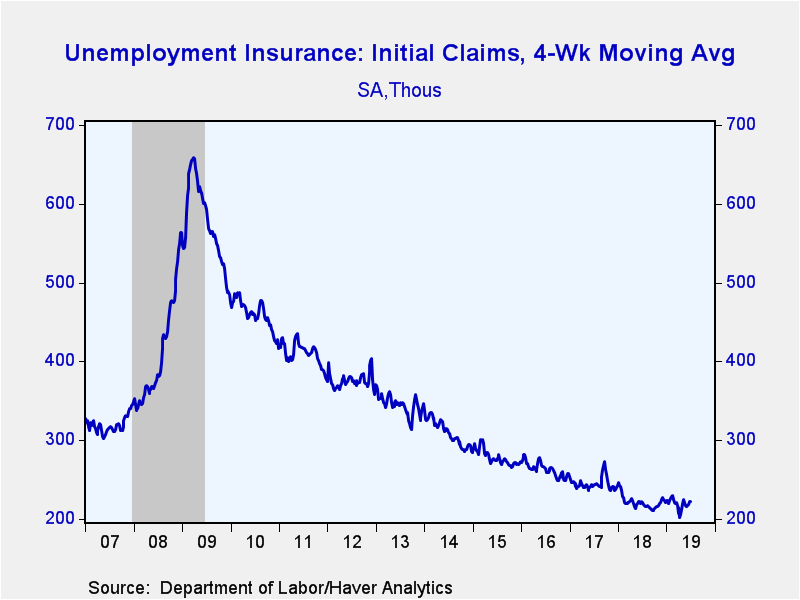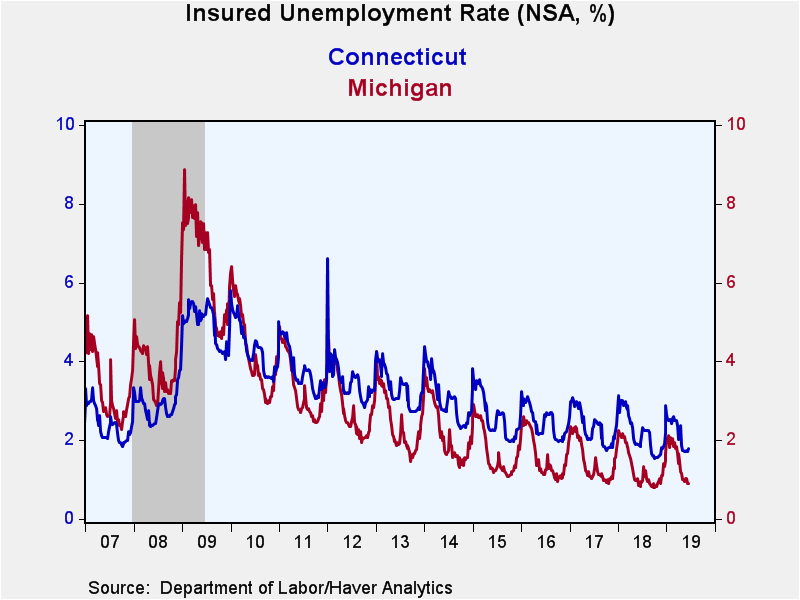 Global| Jul 03 2019
Global| Jul 03 2019U.S. Initial Unemployment Claims Ease, But Stay Within Their Recent Range
Summary
Initial unemployment insurance claims decreased 8,000 to 221,000 in the week ended June 29 from a slightly upwardly revised 229,000 (originally 227,000) the previous week. The consensus expectation in the Action Economics Survey was [...]
Initial unemployment insurance claims decreased 8,000 to 221,000 in the week ended June 29 from a slightly upwardly revised 229,000 (originally 227,000) the previous week. The consensus expectation in the Action Economics Survey was 223,000. The outsized jumps in claims filed the previous week in two states, Connecticut and Massachusetts, appear to have at least partially reversed. The four-week moving average of initial claims was up slightly to 222,250 from 221,750.
Continuing claims for unemployment insurance edged down to 1.686 million in the week ended June 22 from 1.694 million the previous week, which was revised up from 1.688 million initially. The four-week moving average of continuing claims eased to 1.686 million from 1.688 million.
The insured unemployment rate remained at a record low of 1.2% in the week ending June 22, where it has been for since May 2018. This weekly series dates back to 1971. Monthly data start in 1949 and the current 1.2% level is also the lowest ever on that basis.
Insured rates of unemployment vary widely by state. In the week ending June 15, the lowest rates were in South Dakota (0.3%), Indiana (0.4%), Nebraska (0.4), and Florida, New Hampshire, North Carolina, North Dakota, Utah and Virginia, all at 0.5%. The highest rates were in Illinois (1.5%), Pennsylvania (1.7%), California and Connecticut (1.7%) and Alaska and New Jersey (1.9%). Among other large states by population, the rate was 1.1% in Texas, 1.2% in New York and 0.9% in Michigan. These state data are not seasonally adjusted.
Data on weekly unemployment claims going back to 1967 are contained in Haver's WEEKLY database, and they are summarized monthly in USECON. Data for individual states are in REGIONW. The expectations figure is in the AS1REPNA database.
| Unemployment Insurance (SA, 000s) | 06/29/19 | 06/22/19 | 06/15/19 | Y/Y % | 2018 | 2017 | 2016 |
|---|---|---|---|---|---|---|---|
| Initial Claims | 221 | 229 | 217 | -3.8 | 220 | 244 | 262 |
| Continuing Claims | -- | 1,686 | 1,694 | -4.0 | 1,756 | 1,961 | 2,135 |
| Insured Unemployment Rate (%) | -- | 1.2 | 1.2 |
1.2 |
1.2 | 1.4 | 1.6 |
Carol Stone, CBE
AuthorMore in Author Profile »Carol Stone, CBE came to Haver Analytics in 2003 following more than 35 years as a financial market economist at major Wall Street financial institutions, most especially Merrill Lynch and Nomura Securities. She has broad experience in analysis and forecasting of flow-of-funds accounts, the federal budget and Federal Reserve operations. At Nomura Securites, among other duties, she developed various indicator forecasting tools and edited a daily global publication produced in London and New York for readers in Tokyo. At Haver Analytics, Carol is a member of the Research Department, aiding database managers with research and documentation efforts, as well as posting commentary on select economic reports. In addition, she conducts Ways-of-the-World, a blog on economic issues for an Episcopal-Church-affiliated website, The Geranium Farm. During her career, Carol served as an officer of the Money Marketeers and the Downtown Economists Club. She has a PhD from NYU's Stern School of Business. She lives in Brooklyn, New York, and has a weekend home on Long Island.









